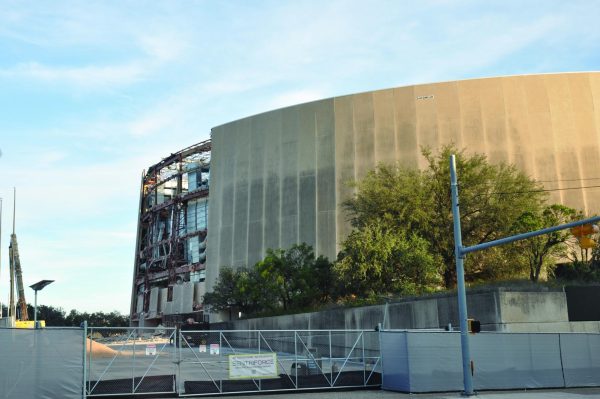2040 Zero Waste Goal on Horizon
November 4, 2019
The City of Austin has started fully implementing a Universal Recycling Ordinance (URO) as part of the city’s Zero Waste by 2040 goal.
The URO is part of the city’s plan that applies to commercial properties and food-selling businesses. The ordinance is one part of the Zero Waste by 2040 goal set forth by the City Council, which aims to keep at least 90 percent of discarded materials out of the city’s landfills. The city has created a master plan to ensure that the goal is met by 2040 or sooner.
Jason McCombs, a planner principle with Austin Resource Recovery, is part of the team that developed the organics amendments to the ordinance. The organics amendment requires restaurants and food-selling businesses to cut back on their food waste. Currently, McCombs manages policy development and implementation of the city’s zero waste efforts.
“All multifamily and commercial properties are required to provide recycling access to their residents,” McCombs said. “Additionally, all food permit holders are required to provide a food donation or composting services to their employees, called organics diversion.”
Susanne Harm, another city employee who works with Austin Resource Recovery, is part of the effort to implement the URO and ensure the zero waste goal is met on time. This amendment was added to the 2010 ordinance after a study was published that found that businesses generate a much larger percentage of waste than households.
“There is an extra limitation for businesses because businesses generate around 85 percent of all the waste that is generated in the landfills,” Harm said. “The resource recovery department only picks up about 15 percent which is usually single-family households, not the businesses, not the apartments. That’s where the URO comes in.”
Initially, the URO was passed and adopted by the City Council in 2010. In 2013, the ordinance was amended to include organic diversion.
“It was implemented in a phase timeline through 2018 based on square footage of the property with the largest properties being affected first,” said McCombs. “The ordinance was fully implemented as of October 2018. Properties were phased in each year from 2013 to 2018 based on the size of the property.”
Bob Gerdot is a retired recycling expert who has worked for more than 40 years in recycling and environmental policy and has led various programs focused on recycling and zero waste since 1975. Gerdot was previously the director of Austin Resource Recovery from 2010 to 2017 when the zero waste plan was adopted and the URO began being implemented.
Gerdot’s department led the city’s efforts toward Zero Waste. He oversaw residential trash, recycling, yard trimmings collection, street sweeping, household hazardous waste collection, bulky item pickups, litter abatement and storm debris cleanup.
“Austin Resource Recovery has a master plan that outlines the strategy to reach zero waste. The last master plan was developed by city staff, industry experts and public input gathered in meetings,” said Gerdot. “The Zero Waste Advisory Commission plays a role in the development of this master plan that was eventually adopted by City Council. Austin Resource Recovery reached 90 percent of the goals in the 2011 master plan and is currently drafting a new master plan that will lay out the next steps to reach zero waste.”
Although the URO doesn’t require the city’s residents to change any of their recycling habits, since it primarily targets businesses and food-service restaurants, it does benefit and affect residents indirectly.
“The URO has an effect on Austin residents everywhere you shop or eat,” said McCombs. “Employees at all these places have convenient methods to divert materials from the landfill, such as composting or donation. This convenient access was not given prior to 2010. Additionally, Austin has a large population of multifamily residents and they should directly benefit from access to recycling.”
In 2015, the city hired a third-party engineering firm to conduct a study on the city’s community diversion. The study was meant to see if the city’s efforts up to 2015 had been effective in working towards the zero waste goal.
“The 2015 study found that Austin was diverting 42 percent of the waste stream from the landfill,” McCombs said. “A follow-up study is anticipated to be completed in 2020 that will measure the diversion rate at that time.”
As of October, the city has begun fully implementing the ordinance. They are hopeful that they will be able to see results soon.
“The 2015 study found that 80 percent of what is currently in Austin’s trash could have been reused, recycled, or composted,” McCombs said. “So while 90 percent diversion is lofty, it is achievable if we can get 80 percent of material of the trash and recycling technology advancement.”









